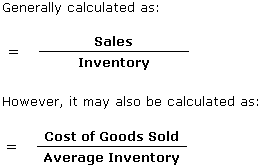Inventory turnover is the rate at which products must be restocked because of customer sales. The ratio showing how many times a company's inventory is sold and replaced over a period follows:

The days in the period can then be divided by the inventory turnover formula to calculate the days it takes to sell the inventory on hand or "inventory turnover days."
Although the first calculation is more frequently used, COGS (cost of goods sold) may be substituted because sales are recorded at market value, while inventories are usually recorded at cost. Also, average inventory may be used instead of the ending inventory level to minimize seasonal factors.
This ratio should be compared against industry averages. A low turnover implies poor sales and, therefore, excess inventory. A high ratio implies either strong sales or ineffective buying.
High inventory levels are unhealthy because they represent an investment with a rate of return of zero. It also opens the company up to trouble should prices begin to fall.